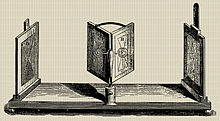Stereoscopy/Background
Introduction
[edit | edit source]



Stereoscopy creates the illusion of three-dimensional depth from given two-dimensional images.[2] Human vision, including the perception of depth, is a complex process, which only begins with the acquisition of visual information taken in through the eyes.
Differences in Images
[edit | edit source]Due to the fact that the view a scenary from different spatial positions, the projections on the retina of the eye differ. The following two images are taken from a horizontally shifted different camera positions.
| Left Eye Image | Right Eye Image |
|---|---|

|
Alignment and Differences Left Right Image
[edit | edit source]Learning Task
[edit | edit source]Analyze the animation above with the alignment of the left and right image. Explain with the principles of perspective drawing, why the left and right image are shifted in the background.
Anaglyph Image - Preview
[edit | edit source]If you have red-green filter glasses, so can view the stereocopy image in Anaglyph 3D.
Image Processing in the Brain
[edit | edit source]Much processing ensues within the brain, as it strives to make sense of the raw information. One of the functions that occur within the brain as it interprets what the eyes see is assessing the relative distances of objects from the viewer, and the depth dimension of those objects. The cues that the brain uses to gauge relative distances and depth in a perceived scene include[3]
- Stereopsis
- Accommodation of the eye
- Overlapping of one object by another
- Subtended visual angle of an object of known size
- Linear perspective (convergence of parallel edges)
- Vertical position (objects closer to the horizon in the scene tend to be perceived as farther away)
- Haze or contrast, saturation, and color, greater distance generally being associated with greater haze, desaturation, and a shift toward blue
- Change in size of textured pattern detail
(All but the first two of the above cues exist in traditional two-dimensional images, such as paintings, photographs, and television.)[4]
Stereoscopy is the production of the illusion of depth in a photograph, movie, or other two-dimensional image by the presentation of a slightly different image to each eye, which adds the first of these cues (stereopsis). The two images are then combined in the brain to give the perception of depth. Because all points in the image produced by stereoscopy focus at the same plane regardless of their depth in the original scene, the second cue, focus, is not duplicated and therefore the illusion of depth is incomplete. There are also mainly two effects of stereoscopy that are unnatural for human vision: (1) the mismatch between convergence and accommodation, caused by the difference between an object's perceived position in front of or behind the display or screen and the real origin of that light; and (2) possible crosstalk between the eyes, caused by imperfect image separation in some methods of stereoscopy.
Although the term "3D" is ubiquitously used, the presentation of dual 2D images is distinctly different from displaying an image in three full dimensions. The most notable difference is that, in the case of "3D" displays, the observer's head and eye movement do not change the information received about the 3-dimensional objects being viewed. Holographic displays and volumetric display do not have this limitation. Just as it is not possible to recreate a full 3-dimensional sound field with just two stereophonic speakers, it is an overstatement to call dual 2D images "3D". The accurate term "stereoscopic" is more cumbersome than the common misnomer "3D", which has been entrenched by many decades of unquestioned misuse. Although most stereoscopic displays do not qualify as real 3D display, all real 3D displays are also stereoscopic displays because they meet the lower criteria also.
Most 3D displays use this stereoscopic method to convey images. It was first invented by Sir Charles Wheatstone in 1838,[5][6] and improved by Sir David Brewster who made the first portable 3D viewing device.[7]


Wheatstone originally used his stereoscope (a rather bulky device)[8] with drawings because photography was not yet available, yet his original paper seems to foresee the development of a realistic imaging method:[9]
For the purposes of illustration I have employed only outline figures, for had either shading or colouring been introduced it might be supposed that the effect was wholly or in part due to these circumstances, whereas by leaving them out of consideration no room is left to doubt that the entire effect of relief is owing to the simultaneous perception of the two monocular projections, one on each retina. But if it be required to obtain the most faithful resemblances of real objects, shadowing and colouring may properly be employed to heighten the effects. Careful attention would enable an artist to draw and paint the two component pictures, so as to present to the mind of the observer, in the resultant perception, perfect identity with the object represented. Flowers, crystals, busts, vases, instruments of various kinds, &c., might thus be represented so as not to be distinguished by sight from the real objects themselves.[5]
Stereoscopy is used in photogrammetry and also for entertainment through the production of stereograms. Stereoscopy is useful in viewing images rendered from large multi-dimensional data sets such as are produced by experimental data. Modern industrial three-dimensional photography may use 3D scanners to detect and record three-dimensional information.[10] The three-dimensional depth information can be reconstructed from two images using a computer by correlating the pixels in the left and right images.[11] Solving the Correspondence problem in the field of Computer Vision aims to create meaningful depth information from two images.
References
[edit | edit source]- ↑ "The Kaiser (Emperor) Panorama". 9 June 2012.
- ↑ Exercises in Three Dimensions: About 3D, Tom Lincoln, 2011
- ↑ Flight Simulation, J. M. Rolfe and K. J. Staples, Cambridge University Press, 1986, page 134
- ↑ Exercises in Three Dimensions, Tom Lincoln, 2011
- ↑ 5.0 5.1 Contributions to the Physiology of Vision.—Part the First. On some remarkable, and hitherto unobserved, Phenomena of Binocular Vision. By CHARLES WHEATSTONE, F.R.S., Professor of Experimental Philosophy in King's College, London. Stereoscopy.com
- ↑ Welling, William. Photography in America, page 23
- ↑ International Stereoscopic Union, 2006, "Stereoscopy", Numbers 65–72, p.18
- ↑ Stereo Realist Manual, p. 375.
- ↑ Stereo Realist Manual, pp. 377–379.
- ↑ Fay Huang, Reinhard Klette, and Karsten Scheibe: Panoramic Imaging (Sensor-Line Cameras and Laser Range-Finders). Wiley & Sons, Chichester, 2008
- ↑ Dornaika, F.; Hammoudi, K (2009). "Extracting 3D Polyhedral Building Models from Aerial Images using a Featureless and Direct Approach" (PDF). Vol. Proc. IAPR/MVA Machine Vision Applications. Retrieved 2010-09-26.


